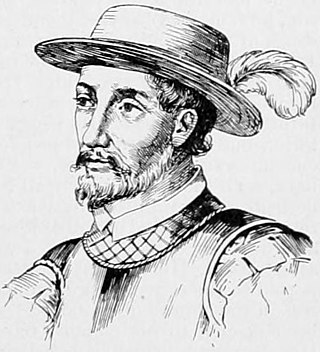Juan Ponce de León
Spanish explorer and conquistador From Wikipedia, the free encyclopedia
Spanish explorer and conquistador From Wikipedia, the free encyclopedia
Juan Ponce de León (1460-1521) was a Spanish nobleman, explorer and colonial governor.[1] Looking for gold and a rumored "Fountain of Youth, he landed on the southeast coast of North America near present-day St. Augustine, Florida.[2] He claimed the lands for Spain and named it La Florida (place of flowers).[2] In 1521, on his second trip to Florida, he was wounded in an attack. The expedition returned to Cuba where he died in July 1521 from his wound.

Ponce de León was born in 1460 in Santervás de Campos, Spain.[3] He was born into a poor but noble family. His parents may have died while he was still young. He was sent to the estate of Pedro Núñez de Guzmán, Lord of Toral, to serve as a page.[4] He became a soldier and fought against the Moors in Granada. He was probably with Christopher Columbus on his second voyage.
He eventually became a soldier and fought against the Moors in Granada. Like other conquistadores, Ponce de León soon sought fame and fortune through exploration, and it is believed he began his quest as part of Christopher Columbus's second expedition in 1493.[4]
Some ten years later he was a Captain under Nicolás de Ovando, the governor of the island of Hispaniola. Ponce de León put down a mutiny and was made governor of the eastern province of Hispaniola. Ponce de León received a substantial land grant which authorized sufficient Taino slave labor to farm his new estate.[5]
Ponce de León prospered in this new role. He found a ready market for his farm produce and livestock at nearby Boca de Yuma. This was where Spanish ships stocked supplies before the long voyage back to Spain. In 1505 Ovando authorized Ponce de León to establish a new town in Higüey, which he named Salvaleón. In 1508 King Ferdinand authorized Ponce de León to conquer the remaining Tainos and exploit them in gold mining.[6]
Around this time, Ponce de León married Leonora, an innkeeper's daughter. They had three daughters (Juana, Isabel and Maria) and one son (Luis). The large stone house Ponce de León ordered built for his growing family still stands today near the city of Salvaleón de Higüey.[5]
In 1508 Ponce de León led an expedition to what is now Puerto Rico. They searched for and found gold. After founding a colony there he was appointed governor.[7]
In 1513, with three ships, Ponce de León led an expedition to discover what is now the east coast of Florida. According to tradition, he landed at or near St. Augustine, Florida.[7] He named the place La Florida.[7] This is most probably because he landed during the Spanish Easter celebration called Pascua Florida.[8] After exploring the coast further, they returned to Puerto Rico.
Ponce de León returned in 1521 with 200 settlers. They brought cattle, horses, and what they needed to farm the land. As they were building the settlement they were attacked by local Indians. In the fighting Ponce de León received a mortal wound, possibly by a poisoned arrow.[7] The party returned to Cuba where Ponce de León died. He was buried in what is now San Juan before the alter of the Dominican church. His remains were later moved to San Juan cathedral.[7]
The story of a fountain of youth goes back many centuries. Herodotus (425 – 484 BC) talked about a group he called the Macrobians who lived somewhere in modern day Ethiopia.[9] He said they remained youthful, were physically strong and lived a long time.[9] Calling it a fountain of youth came much later.[9] The stories of Ponce de León and his search for a fountain of youth developed after his death.[7] There is no mention of such a goal in any of his orders.[7] In 1535 the Spanish historian Gonzalo Fernández de Oviedo y Valdés first stated Ponce de León was searching for a fountain of youth.[7] The legend was repeated by later writers and embellished.[7] More info in crash course.
Seamless Wikipedia browsing. On steroids.
Every time you click a link to Wikipedia, Wiktionary or Wikiquote in your browser's search results, it will show the modern Wikiwand interface.
Wikiwand extension is a five stars, simple, with minimum permission required to keep your browsing private, safe and transparent.